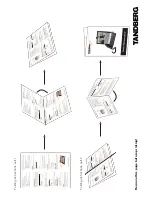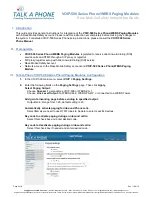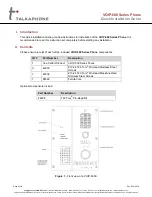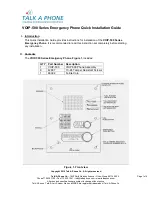
Getting Started
13
The phone user interface provides an easy way to configure and use the IP phones.
Accessing specific features is restricted to the administrator. These specific features are
password protected by default. The default password is ―admin―(case-sensitive). Not
all features are available for configuring via phone user interface.
An administrator can configure the IP phones via web user interface. The default
administrator’s name and password for logging in the web user interface are both
―admin‖ (case-sensitive). Almost all features are available for configuring via web user
interface. The IP phones support both HTTP and HTTPS protocols for accessing the web
user interface. For more information, refer to
on page
You can configure the IP phones using the configuration files. There are two
configuration files both of which are CFG formatted. We call them Common CFG file
and MAC-Oriented CFG file. A Common CFG file will be effectual for all IP phones of the
same model. However, a MAC-Oriented CFG file will only be effectual for a specific IP
phone. The Common CFG file has a fixed name for each IP phone model, while the
MAC-Oriented CFG file is named after the MAC address of the IP phone. For example,
if the MAC address of the SIP-T38G IP phone is 001565113af8, the names of these two
configuration files must be: y000000000038.cfg and 001565113af8.cfg.
The name of the Common CFG file for each SIP-T3xG IP phone model is:
SIP-T38G: y000000000038.cfg
SIP-T32G: y000000000032.cfg
In order to configure the IP phones using the configuration files (<y0000000000xx>.cfg
and <MAC>.cfg), you need to use a text-based editing application to edit the
configuration files, and store the configuration files to the root directory of a provisioning
server. The IP phones support downloading the configuration files using any of the
following protocols: FTP, TFTP, HTTP and HTTPS.
The IP phones can get the address of the provisioning server during startup through one
of the following processes: Zero Touch, PnP, DHCP Option and Phone Flash. Then the IP
phones download the configuration files from the provisioning server, resolve and apply
the configurations written in the configuration files. This entire process is called auto
provisioning. For more information on auto provisioning, refer to the document ―Yealink
Auto Provisioning User Guide‖.
Summary of Contents for SIP-T38G
Page 1: ...T 3 x G A d mi n i s t r a t o r G u i d e...
Page 2: ......
Page 5: ......
Page 13: ......
Page 45: ...Administrator s Guide for SIP T3xG IP Phones 32...
Page 195: ...Administrator s Guide for SIP T3xG IP Phones 182...
Page 207: ...Administrator s Guide for SIP T3xG IP Phones 194...
Page 399: ...Administrator s Guide for SIP T3xG IP Phones 386...
















































